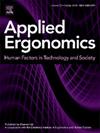The role of notification modality in smartwatches: A context of sedentary behavior interventions
IF 3.4
2区 工程技术
Q2 ENGINEERING, INDUSTRIAL
引用次数: 0
Abstract
Sedentary behavior associated with prolonged computer use poses significant health risks. Smartwatch-based stand-up reminders offer a promising intervention, yet the effectiveness of different notification modalities remains unclear. This controlled laboratory study used a within-subject design to compare four notification modalities: visual-only, visual-auditory, visual-tactile, and visual-auditory-tactile, evaluated using metrics including response times, response rates, compliance times, compliance rates, and user preferences. Twenty participants performed computer-based data processing tasks at a sit-stand workstation while receiving stand-up reminder notifications at random intervals every 7–10 min, prompting them to stand. We hypothesized that multimodal notifications would outperform the visual-only modality in terms of user responsiveness and user preferences. The results supported this hypothesis: both bimodal modalities (visual-auditory and visual-tactile) significantly reduced response times and increased response rates as well as user preferences compared to the visual-only condition (p < 0.001), while performing as effectively as the trimodal condition. Furthermore, response rates were positively correlated with two dimensions of user preferences, confirmation (ρ = 0.497, p < 0.001) and continuance intention (ρ = 0.422, p < 0.001), indicating that user trust and willingness to continue using the system were associated to the system performance. These findings suggest that smartwatch developers and manufacturers should avoid using visual-only notifications as the default and instead promote the use of at least bimodal reminders to enhance user responses and preferences.
通知模式在智能手表中的作用:久坐行为干预的背景
久坐不动的行为与长时间使用电脑有关,对健康构成重大威胁。基于智能手表的站立提醒提供了一种有希望的干预手段,但不同通知方式的有效性尚不清楚。本受控实验室研究采用受试者内设计来比较四种通知方式:仅视觉、视觉-听觉、视觉-触觉和视觉-听觉-触觉,并使用包括响应时间、响应率、依从时间、依从率和用户偏好在内的指标进行评估。20名参与者在坐立两用工作站完成基于计算机的数据处理任务,同时每隔7-10分钟随机收到站立提醒通知,提示他们站立。我们假设,在用户响应性和用户偏好方面,多模式通知将优于纯视觉模式。结果支持这一假设:与仅视觉条件相比,双峰模式(视觉-听觉和视觉-触觉)显著减少了反应时间,增加了反应率和用户偏好(p <;0.001),同时表现得与三模态条件一样有效。此外,回复率与用户偏好确认两个维度正相关(ρ = 0.497, p <;0.001)和继续意愿(ρ = 0.422, p <;0.001),表明用户信任和继续使用系统的意愿与系统性能有关。这些发现表明,智能手表开发商和制造商应避免将仅视觉通知作为默认设置,而应推广使用至少双峰提醒,以增强用户的响应和偏好。
本文章由计算机程序翻译,如有差异,请以英文原文为准。
求助全文
约1分钟内获得全文
求助全文
来源期刊

Applied Ergonomics
工程技术-工程:工业
CiteScore
7.50
自引率
9.40%
发文量
248
审稿时长
53 days
期刊介绍:
Applied Ergonomics is aimed at ergonomists and all those interested in applying ergonomics/human factors in the design, planning and management of technical and social systems at work or leisure. Readership is truly international with subscribers in over 50 countries. Professionals for whom Applied Ergonomics is of interest include: ergonomists, designers, industrial engineers, health and safety specialists, systems engineers, design engineers, organizational psychologists, occupational health specialists and human-computer interaction specialists.
 求助内容:
求助内容: 应助结果提醒方式:
应助结果提醒方式:


